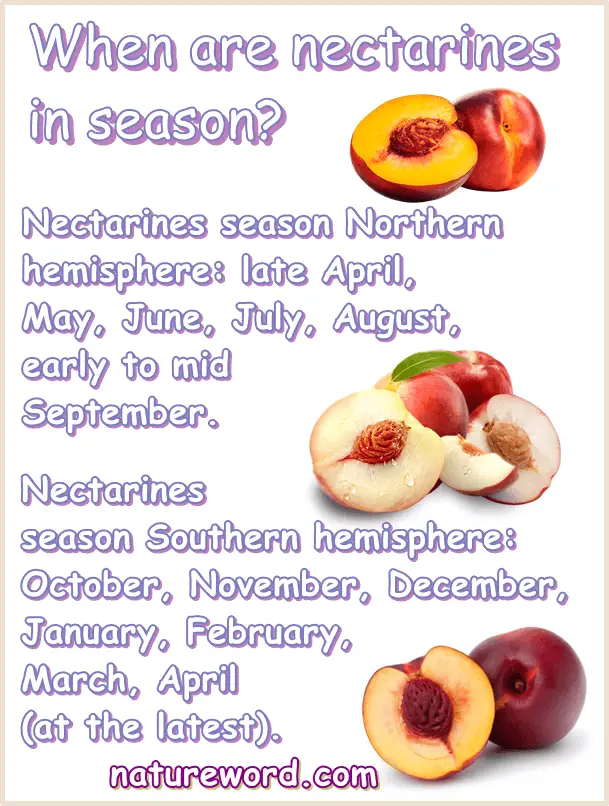Nectarines are in season right now, ripe and ready to eat. But what does that mean? When exactly are nectarines in season by month? Is there a difference between peach and nectarine season? Is there a difference between white nectarines and yellow nectarines season? Do nectarines come into season at different times in the US vs the UK vs Australia vs New Zealand or other regions?
When are nectarines in season?
Nectarine season is roughly late spring to late summer or early fall at the latest. But the seasons are not the same all around the world. The Earth is divided into two hemispheres by latitude: the Northern hemisphere and the Southern hemisphere. In the Northern and the Southern hemispheres the seasons are reversed: when it’s summer in the North, it’s winter in the South. Which also means that nectarine season is also reversed.

Nectarine season by month in the Northern hemisphere
In the Northern hemisphere nectarines are generally in season late spring to late summer or early fall at the latest. By month, that means that nectarine season is April-May throughout August-September. Nectarine season usually starts mid to late May and lasts till late August to early September. However, there are very early season nectarines that are ready to pick and eat late April. Similarly, there are late season nectarines that become ripe early to mid September and are good to eat mid to late September.
Nectarine season by month in the Southern hemisphere
In the Southern hemisphere nectarines are generally in season late spring to late summer or early fall at the latest. But given that the seasons are reversed, that means you have nectarines available during fall-winter months instead of spring-summer.
By month, nectarine season in the Southern hemisphere is roughly October-November through February-March and up until April, depending on the cultivar and exact region.
The start of the season is given by early season nectarines which are ripe and ready to eat October throughout November.
Mid-season fruits are those that ripen December through February, although some consider only December and January fruits as actual mid-season nectarines. Late February through March or April at the latest is late season for nectarines grown in the Southern hemisphere.

Given their extensive cultivation and the fact that the seasons are reversed in the two hemispheres, you can say nectarines are in season right now at any time during the year and likely be right.
The only thing is that right now might mean you are eating nectarines either from Australia or New Zealand, or from the US or UK.
Do know the following:
- There are at least a few dozen different cultivated varieties of nectarines which ripen at different times throughout the season.
In the Northern hemisphere, fruits that are ripe and ready to pick late April or early to mid-May likely do not come from the same nectarine cultivar as fruits that are ripe and ready to eat mid-season (June, July, early to mid August) or late season (late August throughout September).
- Fruits are not all harvested in one go.
Nectarines ripen in succession and are harvested gradually, as they become ready to pick and eat, which means one tree may require several harvests over the course of a few weeks. As a result, fruits harvested from one cultivar may overlap at some point in time with fruits harvested from another cultivar.
Because it’s possible for early and mid-season nectarines or mid-season and late-season nectarines to be present on the market at the same time, even sitting one next to the other, you may buy really good tasting fruits and not so good tasting ones back to back. Unless you know your cultivars really well and know just what to get.
- In addition to climate, differences in yearly weather conditions also have a fundamental impact on nectarine cultivation, fruit harvesting time and fruit taste.
For example, if the weather is unusually warm in a given region one year, nectarines may ripen and become ready to pick and eat earlier than usual in the season. High temperatures and sunny weather together with plenty of rainfall will yield extremely juicy and flavorful fruit at any point in the season.
- Both white nectarines and yellow nectarines are in season at the same time.
White nectarines are nectarines with white flesh. Yellow nectarines are nectarines with golden yellow flesh. Despite the difference in flesh color, the two varieties are the same fruit and have the same season. Indeed, yellow-fleshed varieties are more numerous and cultivated more extensively, and thus better represented on the market compared to white fleshed nectarines.
Find out more about what is a nectarine.
Where do nectarines come from when they are in season?
In the Southern hemisphere, Australia, New Zealand, various countries from South America (e.g. Chile) and South Africa are some of the biggest producers of nectarines.
In the Northern hemisphere, China, Italy, Greece, Spain, Turkey, Iran, the US and Canada are some of the biggest producers of nectarines. In the US, states such as California, Texas and Florida lead production of early and mid-season nectarines due to their convenient geographical placement and focus on agriculture. Other producers include the UK, India, countries in north Africa such as Egypt and more.
Are nectarines in season right now?
Yes, they are. Right now nectarines are in season in the Northern hemisphere. Nectarine season has already started in warmer regions in the US, in Spain, Portugal, Italy, Greece, Turkey, Iran, India, parts of the UK and more. Over the course of the next few weeks nectarine season will also start in other Northern hemisphere countries as well, including countries with a more temperate climate that are just beginning to see warmer weather e.g. Balkan countries such as Romania, Bulgaria, Serbia, Croatia, Hungary, Moldavia and more.
